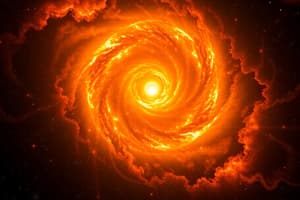Podcast
Questions and Answers
Which process is primarily responsible for energy generation in average stars?
Which process is primarily responsible for energy generation in average stars?
- Alpha ladder process
- Proton-proton chain reaction (correct)
- CNO cycle
- Tri alpha process
What type of nuclear process occurs in the core of red giant stars after they leave the main sequence?
What type of nuclear process occurs in the core of red giant stars after they leave the main sequence?
- Alpha ladder process
- Tri alpha process (correct)
- CNO cycle
- Proton-proton chain reaction
What is the primary mechanism for the creation of elements heavier than iron?
What is the primary mechanism for the creation of elements heavier than iron?
- Supernova nucleosynthesis (correct)
- S-process
- CNO Cycle
- Alpha ladder process
In the context of neutron capture processes, what distinguishes the s-process from the r-process?
In the context of neutron capture processes, what distinguishes the s-process from the r-process?
In which type of star does the CNO cycle primarily occur?
In which type of star does the CNO cycle primarily occur?
What is the result of alpha decay?
What is the result of alpha decay?
What type of process is the 'Alpha ladder process'?
What type of process is the 'Alpha ladder process'?
During stellar evolution, which element is considered as the heaviest element that can be produced through alpha particle fusion in the core of the star?
During stellar evolution, which element is considered as the heaviest element that can be produced through alpha particle fusion in the core of the star?
Which of the following defines a radioactive material?
Which of the following defines a radioactive material?
What is the main difference between s-process and r-process?
What is the main difference between s-process and r-process?
What is the name given to the process of element formation within a star?
What is the name given to the process of element formation within a star?
Which of the following sequences describes the order of events in the Big Bang theory?
Which of the following sequences describes the order of events in the Big Bang theory?
Which of the following best describes an 'isotope'?
Which of the following best describes an 'isotope'?
Which of these elements were primarily formed during Big Bang Nucleosynthesis?
Which of these elements were primarily formed during Big Bang Nucleosynthesis?
What does the term 'stellar' refer to in the context of stellar nucleosynthesis?
What does the term 'stellar' refer to in the context of stellar nucleosynthesis?
What is the term for the smallest unit of matter that forms a chemical element?
What is the term for the smallest unit of matter that forms a chemical element?
What is the significance of the 'recombination' phase in the Big Bang theory?
What is the significance of the 'recombination' phase in the Big Bang theory?
What fundamental concept does the Big Bang Theory attempt to explain?
What fundamental concept does the Big Bang Theory attempt to explain?
What is the relationship between the atomic mass and the nucleus of an element?
What is the relationship between the atomic mass and the nucleus of an element?
What does the 'atomic number' of an element represent?
What does the 'atomic number' of an element represent?
Flashcards
Stellar Nucleosynthesis
Stellar Nucleosynthesis
The process by which heavier elements are formed inside stars through nuclear fusion reactions.
Big Bang Theory
Big Bang Theory
The theory describing the origin and evolution of the universe from a hot, dense state to its current state.
Inflation
Inflation
An initial, extremely rapid expansion of the universe just after the Big Bang.
Singularity
Singularity
Signup and view all the flashcards
Neutron
Neutron
Signup and view all the flashcards
Proton
Proton
Signup and view all the flashcards
Hydrogen
Hydrogen
Signup and view all the flashcards
Helium
Helium
Signup and view all the flashcards
Atom
Atom
Signup and view all the flashcards
Atomic Number
Atomic Number
Signup and view all the flashcards
Radioactive Decay
Radioactive Decay
Signup and view all the flashcards
Alpha Decay (α)
Alpha Decay (α)
Signup and view all the flashcards
Beta Decay (β)
Beta Decay (β)
Signup and view all the flashcards
Gamma Decay (γ)
Gamma Decay (γ)
Signup and view all the flashcards
Proton-Proton Chain Reaction
Proton-Proton Chain Reaction
Signup and view all the flashcards
CNO Cycle
CNO Cycle
Signup and view all the flashcards
Triple Alpha Process
Triple Alpha Process
Signup and view all the flashcards
Alpha Ladder Process
Alpha Ladder Process
Signup and view all the flashcards
Neutron Capture
Neutron Capture
Signup and view all the flashcards
R-Process (Rapid Neutron Capture)
R-Process (Rapid Neutron Capture)
Signup and view all the flashcards
Study Notes
Stellar Nucleosynthesis
- Stellar nucleosynthesis is the process of element formation within stars.
- The Big Bang Theory proposes the universe's beginning with a primordial atom explosion 13 billion years ago.
- This process explains the universe's continuous expansion.
- The Big Bang theory's sequence: singularity, inflation, universe cooled down, recombination, formation of stars and galaxies, continuously expanding and formation of other matter.
- Immediately after the Big Bang, protons and neutrons combined creating light elements like hydrogen and helium. This is known as Big Bang nucleosynthesis. Other elements like Lithium and Beryllium were also formed during this process.
- An atom is the smallest unit of ordinary matter that forms a chemical element.
- Isotopes are various forms of the same element, with the same number of protons but a different number of neutrons.
- Atomic number is the number of protons in an atom's nucleus.
- Atomic mass is associated with the number of protons and neutrons present in an atom's nucleus.
Stellar Nucleosynthesis - Additional Details
- Other lighter elements are formed through processes within stars.
- "Stellar" refers to a star, and nucleosynthesis is the creation of elements inside.
- In stellar evolution, nuclear reactions proceed to produce elements heavier than lithium and beryllium, up to iron.
- During this process, the shells surrounding the star's core have corresponding elements, such as hydrogen and helium burning shell, carbon burning shell, oxygen burning shell and silicon burning inner core
- A star's life cycle: an average star evolves from a stellar nebula to an average star, red giant, planetary nebula, and finally a white dwarf.
- More massive stars evolve into red supergiants, supernova, ending as either neutron stars or black holes.
Radioactive Decay
- Radioactive decay is the process where unstable atomic nuclei lose energy through radiation.
- Common types of radioactive decay include alpha decay (α), beta decay (β), and gamma decay (γ).
Nuclear Fusion in Main Sequence Stars
- The proton-proton chain is the process by which main sequence stars produce energy.
- This chain converts hydrogen into helium.
- The diagram displays that process.
Nuclear Fusion in Massive Stars
- Massive stars use the CNO cycle to convert hydrogen into helium.
- CNO cycle stands for Carbon, Nitrogen, and Oxygen.
- This process is different from the proton-proton chain.
Tri-alpha Process in Red Giant Stars
- The tri-alpha process occurs in red giant stars when they leave the main sequence.
- The process involves helium fusing to form carbon.
Alpha Ladder Process in Super Red Giant Stars
- Alpha ladder processes create heavier elements in super red giant stars via the fusion of helium in a series of steps - similar to the steps in the tri-alpha process but more complex.
Neutron Capture Processes
- Neutron capture involves adding neutrons to a seed nucleus.
- Two types of neutron capture are the slow (s-process), and the rapid (r-process).
- S-process neutron capture has a slow rate of neutron capture and a fast rate of radioactive decay, hence increasing proton numbers by one
- R-process neutron capture has a fast neutron capture rate and thus, a higher rate of neutron combination forming heavier elements than iron. These heavier elements are created via supernova nucleosynthesis, or the explosion of a star.
- Supernova explosions are considered the source of elements heavier than iron.
Studying That Suits You
Use AI to generate personalized quizzes and flashcards to suit your learning preferences.




